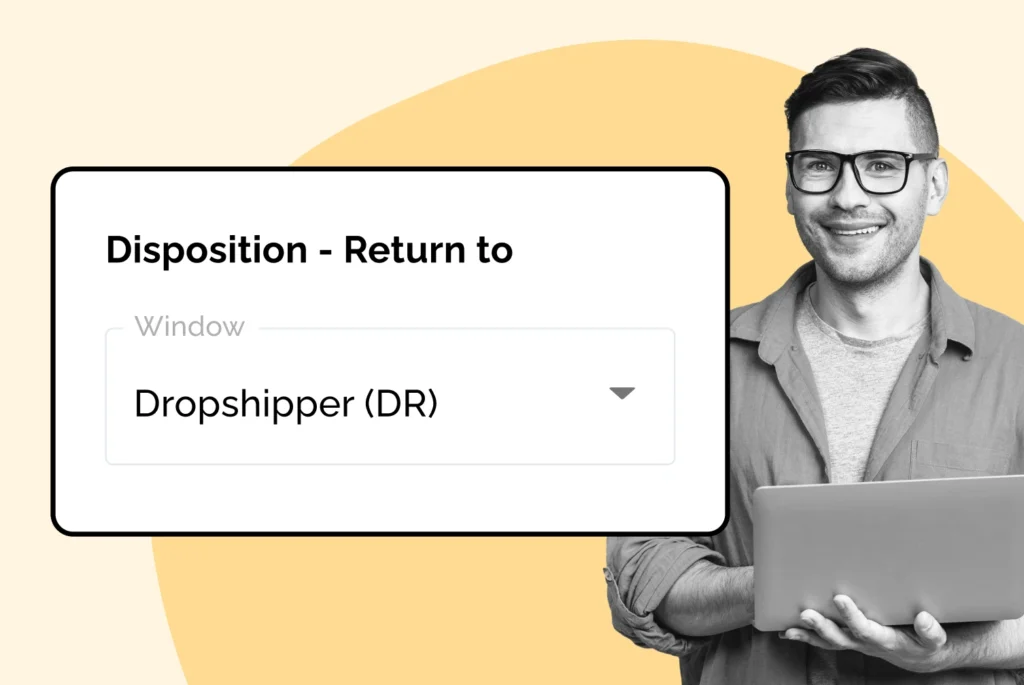
How WeSupply Helps Your Brand Achieve Sustainable Returns
Ler’s explore strategies like carbon offsetting, bulk shipping, and returnless refunds to achieve sustainable performance!
Shipping, Tracking & Notifications
Boost customer experience and reduce support tickets
Realtime order and shipment tracking
Proactive order and shipping notifications
AI-Enhanced Discounted Labels
Predictive pre-purchase estimated delivery dates
Self-Serivce branded order tracking
Effortless experience delivered
Identify and Resolve Order Issues
Realtime order and shipment tracking
Make returns profitable and delight customers
Flexibility to define any return destinations & conditions
Simplify returns for your customers and team
Incentivize exchanges over returns
Returns management made easy for your team
Returns management made easy for your team
Easy claims and smart upsells
Understand why your customers are returning
In-Store & Curbside Pickup
Unify the online and the in-store experience
Hassle-free pickup experience for customers
In-Store dashboard to keep operations streamlined
In-Store and Online orders unified
Drive foot-traffic to your stores
Shipping, Tracking & Notifications
Boost customer experience and reduce support tickets
Realtime order and shipment tracking
Proactive order and shipping notifications
AI-Enhanced Discounted Labels
Predictive pre-purchase estimated delivery dates
Self-Serivce branded order tracking
Effortless experience delivered
Identify and Resolve Order Issues
Realtime order and shipment tracking
Make returns profitable and delight customers
Flexibility to define any return destinations & conditions
Simplify returns for your customers and team
Incentivize exchanges over returns
Returns management made easy for your team
Returns management made easy for your team
Understand why your customers are returning
In-Store & Curbside Pickup
Unify the online and the in-store experience
Hassle-free pickup experience for customers
In-Store Dashboard to keep operations streamlined
In-Store and Online orders unified
Drive foot-traffic to your stores
Boost customer experience and reduce support tickets
Realtime order and shipment tracking
Proactive order and shipping notifications
AI-Enhanced Discounted Labels
Predictive pre-purchase estimated delivery dates
Self-Serivce branded order tracking
Effortless experience delivered
Make returns profitable and delight customers
Flexibility to define any return destinations & conditions
Simplify returns for your customers and team
Incentivize exchanges over returns
Returns management made easy for your team
Equip your team for precise return checks.
Easy claims and smart upsells
Understand why your customers are returning
Unify the online and the in-store experience
Hassle-free pickup experience for customers
In-Store Dashboard to keep operations streamlined
In-Store and Online orders unified
Drive foot-traffic to your stores
Find the answer to all your questions
Take a step by step trip through our functionality to see how we can improve your ecommerce processes.
Explore the most comon questions about WeSupply
Calculate the ROI that WeSupply can bring you
Read actionable articles on how to optimize your post-purchase experience and decrease support tickets
Get inspired by stories of how our customers implemented an effortless post-purchase experience
Wondering if WeSupply is a good fit for you? Read through our use cases to see how we can help you increase conversion & improve CX!
A Deep Dive into Top Companies' Order Tracking & Returns Strategy
Find the answer to all your questions
Explore the most comon questions about WeSupply
Calculate the ROI that WeSupply can bring you
Request a no strings attached review of your current shopping experience and missed conversion opportunities
Take a step by step trip through our functionality to see how we can improve your ecommerce processes.
Read actionable articles on how to optimize your post-purchase experience and decrease support tickets
Get inspired by stories of how our customers implemented an effortless post-purchase experience
A Deep Dive into Top Companies' Order Tracking & Returns Strategy
Wondering if WeSupply is a good fit for you? Read through our use cases to see how we can help you increase conversion & improve CX!

Sustainable returns are essential for online brands aiming to cut down on waste and improve profitability. In this article, we discuss the significant environmental impact of eCommerce returns and practical strategies businesses can implement to manage them sustainably. Understanding these practices can help brands attract eco-conscious consumers and contribute to a greener future while optimizing their operations.
Sustainable returns are essential for reducing the environmental impact of eCommerce, which includes substantial CO2 emissions and significant landfill waste from returned goods.
Implementing strategies such as charging for returns, encouraging exchanges, and adopting energy-efficient shipping methods can mitigate the environmental and financial costs associated with returns.
Eco-conscious consumer preferences are driving the need for businesses to incorporate sustainable practices in their return processes, which can enhance brand loyalty and operational efficiency.
WeSupply helps online brands implement sustainable returns with detailed analytics, pre-built policies, and enhanced shipping practices. Features include green returns, QR code labels, in-store returns, and intelligent dispositions. Achieve efficiency, reduce costs, and boost customer satisfaction. Get started with WeSupply today.
eCommerce returns, often overlooked, have a substantial environmental impact. Annually, they account for up to 24 million metric tons of CO2 emissions, with companies disposing of over 9.5 billion pounds of returned products in landfills. Compared to store purchases, online returns are nearly three times as prevalent, leading to a significant increase in emissions and waste.
The process of handling these returns can take up to three times the initial delivery time, further adding to environmental strain. Understanding this impact is the first step towards creating sustainable return practices that benefit both businesses and the planet.
Although the rapid expansion of eCommerce has transformed the retail industry, it’s also caused a notable increase in returns and waste. The fashion industry exemplifies this issue with a return rate peaking at 40% due to customers frequently indulging in wardrobing – purchasing and wearing an item only once before returning it. In 2021, the return rate for all US purchases was 16.6%, marking a 6% rise from the year before. This spike in returns is attributed to multiple factors such as the ease of online shopping and the growing prevalence of free return policies.
As a result, online shopping generates 4.8 times more packaging waste than brick-and-mortar stores, highlighting the urgent need for sustainable return practices.
Sustainable returns are not just a trend; they are a necessity for businesses aiming to reduce their environmental footprint and align with eco-conscious consumers. Each year, 5 billion pounds of returned goods in the US end up in landfills, generating 15% more landfill waste compared to brick-and-mortar returns. Implementing sustainable returns can help businesses attract and retain loyal customers who value environmental responsibility.
Moreover, optimizing the reverse supply chain through returns management solutions can mitigate the negative environmental impact of returns. Charging customers for returns instead of offering free returns can also deter unnecessary returns and bracketing practices.
The implementation of sustainable returns presents a complex challenge requiring a balance between environmental and financial costs. Viewing returns only as a cost center can have adverse effects on both the environment and a business’s long-term viability. This task becomes even more intricate when dealing with electronics returns due to legal compliance and data security considerations. Furthermore, liquidation of returned electronics without adequate testing can pose legal and reputational risks.
Therefore, businesses must adopt a holistic approach that considers both the environmental impact and customer preferences.
Returns carry a multi-dimensional cost burden, covering environmental and financial considerations. From an environmental perspective, returns add to the waste and emissions as returned goods frequently end up in landfills or necessitate extensive repackaging and transportation. Financially, returns can impose significant costs on brands, particularly in handling opened packages and managing reverse logistics. Dealing with electronics returns adds another layer of complexity with the need for legal compliance and data security.
At WeSupply, we understand that returns are not just a financial burden but also an environmental challenge. Our innovative return process solutions are designed to minimize waste, streamline operations, and reduce the carbon footprint of your business. By optimizing return logistics and promoting sustainable practices, WeSupply helps you lower operational costs while contributing positively to the environment.
Want to see how sustainable returns can boost your ROI? Use our ROI Calculator to discover the impact today!
Eco-conscious consumers are increasingly driving the demand for sustainable practices in eCommerce. These consumers expect businesses to incorporate ESG (Environmental, Social, and Governance) considerations into their return processes. Implementing sustainable returns can enhance corporate social responsibility and green business practices, helping businesses build a circular economy within the supply chain.
By responding to these consumer preferences, businesses can not only improve their sustainability performance but also foster stronger customer relationships and brand loyalty.
The adoption of sustainable return practices translates into numerous benefits for businesses and the environment alike. These practices can:
Enhance operational efficiency
Curtail waste
Decrease overall costs
Fuel revenue growth by promoting brand recognition and attracting new customers.
Green business practices offer several benefits, including:
Reducing the risk associated with supply chain shortages and resource scarcity
Enhancing brand image and distinguishing businesses in a competitive market
Attracting environmentally conscious consumers
By embracing sustainable practices, businesses can contribute to a greener future while also reaping these benefits.
Sustainable return practices provide substantial environmental and social benefits. They help decrease transportation-related emissions by establishing localized return centers and using biodegradable or reusable packaging. These practices also support the fair treatment and compensation of people involved in the supply chain, contributing to community engagement and social responsibility.
Around 73% of shoppers are willing to change their consumption habits to reduce their environmental impact, making sustainable returns a critical component of a business’s sustainability goals.
Eco-friendly practices can build trust and loyalty among environmentally conscious consumers. Consumers increasingly prefer to purchase from companies that help them improve their own environmental and social footprint. Implementing sustainable return policies can foster stronger customer relationships, as eco-conscious shoppers are more likely to remain loyal to brands that prioritize environmental responsibility.
Providing a smooth and sustainable return experience can drive repeat purchases, as customers appreciate the commitment to environmental sustainability. Embracing sustainability can enhance brand purpose and attract new customers, making it a win-win for businesses and the environment.
The implementation of sustainable returns requires a strategic approach, commencing with an evaluation of current practices and the establishment of measurable objectives. Business sustainability can yield a healthier world and healthier profits simultaneously. The annual contribution of returned goods to CO2 emissions and landfill waste stands at 27 million metric tons and 9.6 billion pounds respectively, underscoring the necessity for optimized return processes.
By incorporating sustainable returns, businesses can reduce waste and improve resource efficiency.
Assessing current return practices is the first step toward implementing sustainable returns. Businesses should:
Measure resource consumption
Assess waste generation and carbon emissions
Analyze process efficiency
Track the volume of returns to highlight inefficiencies in product quality or misalignment with customer expectations.
Conducting regular audits of return policies ensures they align with board governance, sustainability goals, and customer satisfaction.
Setting measurable sustainability goals is crucial for guiding businesses in implementing sustainable returns. Focusing on key areas such as:
packaging
shipping
return rates
returned items
Helps plan and prioritize efforts in senior management roles. Developing KPIs to track business sustainability efforts is essential for measuring success.
Defining clear, time-bound targets for reducing return rates can focus efforts and measure progress. Utilizing data analytics to set realistic and achievable sustainability benchmarks based on historical return data can further enhance these efforts.
WeSupply’s Returns Analytics can significantly enhance your strategies for implementing sustainable returns by helping set measurable sustainability goals. By understanding why customers are returning products and identifying the most frequently returned items, businesses can gain actionable insights to reduce return rates. Detailed SKU-level returns analytics allow for the quick identification of return reasons at the product and variant levels, including factors such as color, quality, and size. This deeper understanding enables businesses to improve product offerings, ultimately reducing waste and fostering a more sustainable return process.
WeSupply offers an environmentally-friendly returns management platform designed to enhance efficiency, reduce costs, and improve customer satisfaction. The platform leverages several innovative features to streamline the return process and minimize environmental impact:
Return In-Store or via Curbside: Facilitates convenient returns at participating locations like Target, Walmart, Nordstrom, and DSW.
Printerless Returns via QR Code: Enhances customer experience by allowing returns without the need for a printer, with QR code drop-offs available at FedEx Office, Walgreens, and USPS locations.
Generate Return Labels Automatically: Enables customers to generate return labels effortlessly, ensuring smooth returns even when staff is unavailable.
Green Returns: Allows customers to keep low-cost items, saving on shipping costs and reducing waste.
Non-Returnable Items: Provides clarity on which items are returnable, eliminating uncertainty and unnecessary communication.
This comprehensive approach ensures quicker refunds, transparent handling of returns, and a reduced carbon footprint.
Create custom return policies
There are many moving pieces in ecommerce logistics. Book a quick call with our experts to see how WeSupply can help you take control by creating custom policies to handle them all easily. You get to decide how you want to handle final sale items, return window lengths, return request approvals, and more.
Rudsak, a prominent fashion brand, aimed to enhance customer satisfaction and operational efficiency by refining its return and exchange processes, particularly focusing on gift card refunds and exchanges. Facing challenges such as managing exchanges for specific product variants, handling non-returnable items, and integrating a seamless solution, Rudsak partnered with WeSupply.
Exchange Management: Handling exchanges for same-priced product variants, utilizing inventory from multiple store locations, and ensuring new orders were dispatched post-approval.
Non-Returnable Items: Implementing rules for sale items and POS orders.
Integration Needs: Automating return approvals and generating return labels.
Seamless Integration: Efficiently managed exchanges, returns, and gift card refunds through integration with Rudsak’s systems.
Exchange Rules Implementation: Allowed exchanges only for same-priced variants with available inventory.
Gift Card Refunds: Provided flexible refunds via gift cards.
Automated Approval and Return Labels: Enabled automatic approval and generation of return labels, covering the cost.
Non-Returnable Items Management: Implemented rules for marking sale items and POS orders as non-returnable.
Efficient Exchange Processing: Simplified and accurate management of exchanges.
Enhanced Customer Satisfaction: Improved communication and faster processing times.
Reduced Customer Service Queries: Fewer inquiries due to clear and proactive communication.
Managed Non-Returnable Items: Clear rules reduced disputes and enhanced transparency.
Proactive Notifications: Kept customers informed and engaged, boosting post-purchase satisfaction and brand loyalty.
Restricting free returns constitutes a pivotal strategy for boosting sustainability, though it necessitates delicate balancing to prevent customer attrition. Retailers such as Anthropologie, H&M, and REI have begun to charge for returns, veering away from free return policies.
Additionally, some retailers have reduced their return windows to a month and offer store credit instead of refunds. These strategies can help reduce the environmental impact of returns while maintaining customer satisfaction.
Free returns can significantly impact sustainability by:
Increasing carbon emissions and waste
Contributing to pollution and greenhouse gas emissions through the logistics and labor involved in processing returns
Generating material waste from repackaging returned products, which often ends up in landfills and contributes to environmental degradation.
Providing customers with information about the environmental impact of return options can lead them to choose more sustainable methods, such as in-store returns.
While limiting free returns can be challenging, there are effective strategies to do so without losing customers. Encouraging customers to read product descriptions carefully and providing detailed sizing charts can help reduce unnecessary returns. Offering virtual try-on options and augmented reality (AR) tools can help customers better assess fit and style, potentially reducing returns.
Providing incentives, such as covering return shipping for exchanges or offering loyalty points, can encourage customers to keep products.
WeSupply’s Pre-built Return Policies can effectively help limit free returns, providing a balanced approach to cost management and customer satisfaction. Key features include:
Personalized Products Are Non-returnable: Enhance inventory management and reduce losses by prohibiting returns on personalized items, balancing customization with return policies.
Offer Free Returns on Exchanges: Boost customer loyalty and purchase satisfaction by providing free return shipping on exchanges, enhancing the shopping experience.
Explore our other Pre-built Return Policies to streamline your return process and improve your overall business efficiency.
Encouraging customer retention plays a crucial role in minimizing returns and fostering sustainability. It’s nearly five times less expensive to retain existing customers than to acquire new ones, leading to a significant profit boost. A smooth returns process can have a positive impact on customer retention, considering 92% of customers are likely to repurchase if the return experience is untroubled.
By offering alternatives to returns and encouraging exchanges, businesses can maintain long-term relationships with their customers.
Encouraging exchanges and offering store credit can help minimize returns and waste. Here are some strategies to consider:
Gamification: Implement a rewards program where customers can earn points or rewards for opting for exchanges instead of returns.
Free shipping on exchanges: Offer free shipping on exchanges to make it more convenient for customers to choose this option.
Additional incentives: Provide extra store credit or discounts for customers who opt for exchanges, to encourage them to make future purchases instead of seeking refunds.
These strategies can help incentivize customers to choose exchanges over returns, reducing waste and improving customer satisfaction.
A seamless exchange process can enhance customer retention and improve brand reputation by demonstrating a commitment to meeting customer needs.
WeSupply can help you encourage exchanges and store credit, transforming returns into opportunities for increased sales and customer loyalty. Key features include:
Convert Returns into Exchanges:
Exchange return items with any product
Reship the same item
Exchange for the same value item
Exchange for a higher valued item
Incentivize Exchanges Over Returns:
Save sales through exchanges and boost the average order value using instant store credit.
Reward customers who choose instant store credit over refunds.
Send customers back to your product catalog after they initiate a return.
Refund to Store Credit, Gift Card, or Coupon Code:
Entice customers to return and shop more often by offering refunds as store credits.
Build a trusting relationship with customers.
Make exchanges easy by sending customers back to your website to shop for any product regardless of price.
Use store credit or gift cards as partial payment.
Increase order value.
Book a demo today to see how WeSupply can optimize your return process and drive customer retention.
Environmentally friendly packaging solutions can cut down on waste and enhance a brand’s sustainability initiatives. Opting for recyclable, reusable, and biodegradable materials significantly trims down packaging waste and the environmental impact of eCommerce returns. Meanwhile, minimalistic packaging can further contribute to waste reduction without compromising product protection during shipping.
Adopting these packaging solutions can enhance a brand’s reputation and appeal to eco-conscious consumers, aligning with broader sustainability goals.
Adopting sustainable return shipping practices is vital to decrease the carbon footprint linked with conventional returns. Substantial cuts in fuel consumption and greenhouse gas emissions can be achieved through last-mile delivery optimization, the use of zero-emissions fleets, and energy-efficient shipping methods.
Implementing returnless refunds, encouraging in-store returns, and using on-demand return shipping labels can also minimize unnecessary shipments and reduce waste.
Returnless refunds can:
Save resources and reduce waste by eliminating the need to ship unwanted products back to the retailer
Enhance customer satisfaction by allowing customers to keep products they wish to return while still receiving a refund
Reduce logistical challenges for retailers
Lower waste and carbon emissions
Amazon pioneered this concept and it has proven to be a successful practice.
Businesses must set clear rules and select appropriate products to effectively implement returnless refunds and mitigate potential fraud.
Encouraging in-store returns can minimize shipping emissions and waste. In-store returns allow for immediate inspection and restocking of items, reducing the resources needed for shipping and handling returns. This practice can also boost store foot traffic, potentially leading to additional sales.
Companies like Abercrombie & Fitch and Target have successfully implemented in-store returns for online purchases, providing convenience for customers and enhancing loyalty.
On-demand return shipping labels can:
Reduce waste
Improve efficiency
Provide labels only when necessary
Minimize unused labels
Support eco-friendly practices
This practice ensures that return labels are used only for actual returns, minimizing unused labels and supporting eco-friendly practices.
Pre-paid return shipping labels also ensure that return packages are delivered to the correct address, minimizing the risk of lost or undelivered items.
WeSupply can enhance your sustainable return shipping practices, reducing waste and improving customer satisfaction. Key features include:
Non-Returnable Items: Customers can quickly determine which goods are returnable, eliminating uncertainty and reducing unnecessary communication.
Green Returns: Allow customers to keep low-cost items when requesting a return, saving on return shipping costs and increasing customer satisfaction by providing quick refunds or exchanges without requiring item shipments.
Generate Return Labels Automatically: Enable customers to generate return labels automatically, ensuring smooth returns even when staff is unavailable.
Printerless Returns via QR Code: Improve customer experience by allowing printerless returns with QR codes, enabling easy drop-offs at FedEx, Walgreens, and USPS locations.
Return In-Store or via Curbside: Offer convenient in-store or curbside returns, following the example of major retailers like Target, Walmart, Nordstrom, and DSW.
Intelligent Dispositions: Optimize the process of handling product returns by dynamically routing items to the most suitable locations based on predefined rules, enhancing efficiency, reducing costs, accelerating the return process, and ensuring quicker refunds and transparent handling of returns.
Experience the benefits of WeSupply’s sustainable return practices and streamline your returns process today.
Sustainable management of returned items is crucial to minimize waste and foster a circular economy. Sustainable return practices can align with business goals and customer expectations, all while cutting down on waste and emissions.
Strategies such as reselling, refurbishing, and recycling returned items can minimize the environmental impact of returns and support sustainability goals.
Reselling returned products can recoup costs and reduce waste by giving products a second life. Returned items can be sold at lower prices, attracting cost-conscious customers and minimizing waste. Leading companies like Best Buy and HP have established online outlets for reselling returned or open-box items, promoting a circular economy and reducing the environmental impact of returns.
Refurbishing returned products involves cleaning, inspecting, and testing to ensure they can be resold in good condition. This practice extends the life of products and reduces the need for new resources, promoting sustainability.
Refurbishing IT products, for example, helps extend their operational life and enhances performance through thorough testing. Choosing refurbished over new products significantly reduces e-waste and the associated environmental impact.
Recycling materials from returned items can significantly reduce waste and promote sustainability. Partnering with local recycling facilities can help manage the recycling of returned items’ materials, ensuring they are appropriately processed and reused.
Many materials from returned products can be recycled, reducing landfill waste and pollution. Some common materials that can be recycled include:
Plastics
Cardboard
Glass
Paper
Aluminum
Recycling returned items supports a circular economy by repurposing materials for new products.
Data utilization can empower businesses to:
Make well-informed decisions regarding sustainable practices
Facilitate data analysis and the identification of improvement areas
Support sustainability policies grounded in evidence
Enrich customer experiences
Streamline operations
Boost business performance
By incorporating environmental intelligence into decision-making processes, businesses can gain a competitive advantage and reduce their environmental impact.
Identifying patterns in return data can guide sustainability efforts. Data-driven insights help uncover trends and patterns related to America’s clean energy sector, renewable energy adoption, resource conservation, and waste reduction, supporting evidence-based policymaking for sustainable development.
By analyzing transportation data, city governments can identify areas with significant traffic congestion and air pollution and implement policies promoting public transportation to reduce emissions. Data-driven decision-making transforms raw data into actionable insights, enhancing customer experiences and streamlining operations.
Analyzing return rates and customer feedback can help improve sustainable practices. Return rates can reveal patterns and underlying issues in product quality or customer satisfaction, guiding organizations to address these areas and improve sustainable practices. Automated analysis of customer feedback and return reasons can pinpoint common issues, allowing businesses to address these problems proactively.
Regularly monitoring return rates helps identify if changes made to product descriptions or quality are effective.
WeSupply helps you turn data into meaningful action, making it easier to reduce waste and keep your customers happy. Key features include:
Understand why customers are returning products.
Identify the most returned products and the reasons for returns.
Detect which customers are serial returners.
Reduce return rates with actionable insights.
Access returns data in BigQuery for in-depth analysis.
Measure and track key metrics to improve the post-purchase customer experience.
Easily track Customer Satisfaction (CSAT) and Net Promoter Score (NPS).
Utilize data-driven decision-making to fine-tune and adapt to customer needs.
The implementation of a sustainable returns process aids in minimizing environmental impact, curtailing waste, and reducing operational costs. Brands can lessen the environmental impact of returns by optimizing the reverse supply chain and utilizing returns data to make sustainable business decisions. Essential focus areas for sustainability encompass eco-friendly packaging, carbon emissions reduction, and efficient resource utilization.
By adopting sustainable practices and demonstrating effective corporate stewardship, businesses can enhance their sustainable performance and align with their company’s existing strategy for pursuing similar sustainability objectives. Sustainability executives play a crucial role in achieving similar sustainability objectives in broader goals.
Using a Returns Management System (RMS) can streamline the sustainable returns process. An RMS automates and streamlines the returns process, making it more efficient and sustainable. Features of RMS include:
Returns authorization
Inventory management
Refund processing
Analytics and reporting
These features provide valuable insights into returns trends and customer feedback.
Integrating RMS with other eCommerce systems like warehouse management and shipping providers can further simplify the management and tracking of sustainable practices.
WeSupply helps you implement a sustainable returns process using a robust Returns Management System (RMS), streamlining the entire returns experience while enhancing customer satisfaction. Key features include:
Self-Service Returns Process: Provide a frictionless eCommerce returns experience, giving shoppers complete control over the return process.
Create Flexible Returns Rules to Match Any Use Case: Design a hassle-free return policy with flexible return logics tailored to different scenarios.
Autogenerated QR Code Return Labels: Simplify returns with QR codes, eliminating the need for customers to print labels.
Returns Tracking: Allow customers to track the progress of their returns and check status updates with ease.
Post-Purchase Email & SMS Notifications: Keep customers informed with return shipping notifications and offer personalized deals to encourage repeat business.
Offer Instant Credit to Encourage Exchanges: Incentivize exchanges over refunds, reducing return rates and boosting average order value with instant store credit.
Buy Online, Return In-Store: Enhance convenience by allowing customers to return online purchases in-store.
Experience the efficiency and customer satisfaction of a sustainable returns process. Book a demo with WeSupply today.
Combat inconvenience with proactivity & self service
Book a quick call with our experts to see how WeSupply can help you make returns easy for your customers with a beautiful, self-service solution that makes their experience easier while also providing new ways to lower costs and earn back revenue.
Sustainable returns carry financial implications such as potential cost savings and enhanced operational efficiency in financial markets. Sustainable investing spans various asset classes, including alternative investments, and targets competitive financial returns, with sustainable investment funds frequently yielding comparable or superior financial returns than traditional investments. A well-planned investment strategy can help investors navigate these opportunities effectively.
During periods of market volatility, sustainable funds tend to be more stable and exhibit lower downside risk compared to traditional funds. By incorporating ESG criteria in investments, businesses can achieve steadier performance and even provide a performance advantage in some cases.
Sustainable returns can lead to cost savings and improved efficiency by reducing waste and optimizing processes. Reverse logistics helps maintain accurate inventory levels, reducing the need for excess stock and lowering storage costs. Engaging in recycling and refurbishing activities can qualify businesses for government incentives related to environmental sustainability.
By reintegrating viable goods quickly into inventory, reverse logistics reduces the financial impact of holding returned items. Streamlining processes through automation can save time and money by reducing manual labor costs.
The long-term ROI of sustainability efforts can benefit both businesses and the environment. Studies indicate that integrating environmental, social, and governance (ESG) factors into investment analysis correlates with superior long-term risk-adjusted returns. Sustainability practices in companies are linked to better operational performance, which translates into improved cash flows.
By 2026, the following predictions are made:
60% of public companies will include sustainability metrics in their ROI analysis
30% of debt capital market funding will be directed towards ESG initiatives
Companies with high ESG scores experienced significantly greater shareholder returns than those with average scores.
WeSupply can help you achieve long-term ROI from your sustainability efforts by optimizing your returns process, reducing waste, and enhancing customer satisfaction. By implementing data-driven strategies and sustainable practices, you can lower operational costs, increase customer loyalty, and boost overall profitability. Discover the financial impact of sustainable returns with our ROI Calculator and see how WeSupply can transform your business.
Communicating sustainability initiatives can boost brand reputation and draw in eco-conscious consumers. Here are some key strategies to consider:
Incorporate sustainability into your return policy.
Clearly convey your sustainability mission to foster an emotional connection with customers.
Avoid greenwashing and establish trust by being transparent in your sustainability claims.
By implementing these strategies, you can effectively communicate your commitment to sustainability and attract environmentally conscious consumers.
By effectively communicating your sustainability efforts, you can improve visibility and align with consumer values, fostering stronger customer relationships and brand loyalty.
Embracing sustainable returns is an ongoing journey that benefits businesses, consumers, and the environment. The ongoing journey toward sustainability involves continuous improvement and adaptation to new challenges and opportunities.
By adopting sustainable return practices, businesses can reduce their environmental footprint, enhance their brand reputation, and attract eco-conscious consumers. The benefits for brands and the environment are clear, making sustainable returns a core focus for eCommerce businesses striving to build a sustainable future.
WeSupply offers comprehensive solutions to help online brands implement sustainable returns, transforming the process into an efficient and customer-friendly experience. Leveraging detailed SKU-level returns analytics, businesses can understand return reasons, reduce rates, and improve product offerings. Pre-built return policies balance cost management with customer service, while encouraging exchanges and offering store credits boost sales and loyalty. Enhanced return shipping practices include non-returnable items, green returns, autogenerated QR code labels, and convenient in-store or curbside returns. Intelligent dispositions optimize handling by routing items to suitable locations, reducing costs and ensuring quicker refunds. With a branded returns portal, self-service options, flexible return rules, returns tracking, and post-purchase notifications, WeSupply ensures a seamless and satisfying returns experience.
Sustainable investing does not necessarily lead to lower returns and may even achieve comparable or better financial results than conventional investments. Data from Morningstar in 2022 shows that sustainable investing generated returns similar to those of the overall market.
Sustainable returns are important for eCommerce businesses because they reduce environmental impact, lower operational costs, and improve brand reputation by aligning with eco-conscious consumer values. These factors contribute to long-term success.
WeSupply’s Pre-built Return Policies limit free returns, balancing cost management and customer satisfaction. They include charging shipping fees based on return reason, prohibiting returns on personalized items, and offering free return shipping on exchanges, streamlining the return process and enhancing business efficiency.
WeSupply transforms returns into sales opportunities with features like converting returns into exchanges, incentivizing exchanges over returns with instant store credit, and offering refunds as store credits, gift cards, or coupons. This approach boosts customer loyalty and order value.
WeSupply reduces waste and improves customer satisfaction with non-returnable items, green returns, autogenerated return labels, printerless returns via QR codes, and convenient in-store or curbside returns. Intelligent dispositions optimize return handling, ensuring quicker refunds and transparency.
Yes, WeSupply does have an official Shopify App. You can download and begin to integrate it with your Shopify store.
Yes, WeSupply has an official extension for Magento. The WeSupply x Magento integration allows for automating order tracking experiences, reducing customer inquiries, automating shipping email and SMS notifications, and providing a fully branded order tracking experience
Yes, WeSupply has an official BigCommerce App. You can integrate WeSupply with your BigCommerce store to improve your post-purchase customer experience.
Learn How To Create Successful Post Purchase Email Campaigns
Build an effective post-purchase email flow that helps you increase customer satisfaction and drive revenue growth!

Ler’s explore strategies like carbon offsetting, bulk shipping, and returnless refunds to achieve sustainable performance!

This article will show you how to optimize the sales and return process for swimwear, boosting customer satisfaction and revenue!

Practical strategies to optimize returns and exchanges for online furniture stores, helping reduce costs and improve customer satisfaction.

This article unpacks how pre-paid labels can both improve the return experience for customers and streamline operations for retailers.

Discover through our comprehensive guide how recommerce is reshaping the retail space, driving economic value, and fostering environmental sustainability.

Managing dropshipping returns requires clear, actionable strategies. Turn them into a source of customer trust rather than frustration!
Let’s explore how tracking systems can enhance customer satisfaction, improve operational efficiency, and provide valuable business insights!

Learn the tangible benefits this integration delivers, as we unpack the advantages and practical steps of merging these powerful tools.

Discover how to refine your returns process, address common issues, and emerge as a leader in a customer-centric market!